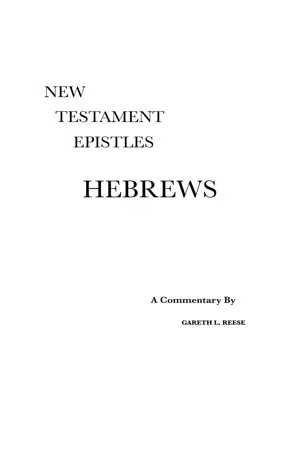
- English
- ePUB (mobile friendly)
- Available on iOS & Android
About This Book
This is a phrase-by-phrase commentary and exposition of the New Testament book of Hebrews. This commentary is in use as a college textbook, yet is suitable for the lay church member.
Hebrews is one of the great sources for instruction in Christian faith, and for exhortations to faithfulness to Christ and His message. From start to finish, the writer of Hebrews demonstrates the superiority of Jesus Christ, His message, and His covenant. For those of us living under this New Covenant, our desire to be faithful to Jesus Christ is based on the Son of God’s superiority as a messenger, on the superior priestly line from which the Son of God comes, and on the once-for-all efficacy of the sacrifices and work which the Son of God has offered on our behalf. From start to finish, the exhortations and warnings contained in Hebrews point us to Jesus Christ Himself; He is the superior source and object of our desire to live “by faith.”
This commentary is conservative evangelical Christian in its outlook, yet skillfully examines Scripture from multiple theological viewpoints. Introductory Studies cover canonicity, authorship and attestation, the original target audience addressed, place and date of writing, and the original author's purpose for writing. The Introductory Studies also discuss questions raised about Hebrews by form critics – i.e., literary and rhetorical analysts of the Biblical literature – regarding the structure of the book, in order to answer the question, Is Hebrews a treatise, a sermon, or an epistle? The topic of covenants and covenant theology is addressed in a special Appendix. Finally, this commentary provides a unique and compelling outline for the book, based on the exposition of key Old Testament passages central to each section of Hebrews and the summary explanations provided by the Hebrews writer himself at 8: 1 and 13: 22.
Since this commentary presumes the God-inspired nature of all Biblical writing, the author seeks to harmonize the teachings of Hebrews with other relevant Scriptures, and also helpfully examines the original language in which the epistles were written. An annotated bibliography of other commentaries on Hebrews is included to encourage readers to extend their own studies.
This volume continues the author's commentary series on the books of the New Testament, and is written from the unique standpoint of the Restoration Movement, a position which allows him to approach Scripture with no special theological doctrine or dogma to defend and explicate. This approach provides unhindered freedom to listen to what the Holy Spirit would tell us within the pages of the Scripture. By deliberately employing the time-honored grammatico-historical method of interpretation, the Word of God is allowed to impress upon our minds the intent the Divine Author had in mind.
In the past, Restoration Movement preachers preached regularly from the bo
Frequently asked questions
Information
B. His Ministry is Superior Because It Occurs in a Better Sanctuary. 9:1-28
Table of contents
- TO THE HEBREWS
- The Table of Showbread